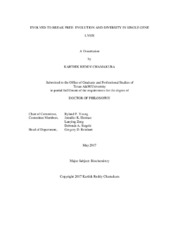| dc.description.abstract | mall lytic phages compelled by the same evolutionary pressures as large dsDNA phages have evolved mechanisms to lyse their hosts efficiently and at optimal times to ensure maximum fecundity. The ssDNA Microviridae and ssRNA Leviviridae, with extremely small genomes (<6kb), effect lysis with a single gene. The most studied single-gene lysis systems (SGL) are gene E of the canonical microvirus PhiX174 and genes A2 and L of the paradigm ssRNA phages Qβ and MS2, respectively. All three lysis proteins lack muralytic activity, and two, A2 and E, have been shown to function as “protein antibiotics” by acting as noncompetitive inhibitors of conserved peptidoglycan (PG) biosynthesis enzymes, MurA and MraY, respectively. The third, L of MS2, does not inhibit PG biosynthesis but instead is hypothesized to trigger host autolytic response through an unknown mechanism.
The work described in this dissertation identifies a chaperone involved in MS2 L-mediated lysis, the minimal lytic domain of L, and a new paradigm in SGL that resolves a long-standing debate in peptidoglycan biosynthesis. Using a genetic approach, dnaJ was shown to be required for L-mediated lysis. DnaJ was shown to form a complex with L and this interaction is abrogated in the absence of the highly basic N-terminal half of L. Mutational analysis of L has revealed that most critical residues are clustered around a highly-conserved LS motif. To determine if SGL evolved at different genomic locations target other steps in PG biosynthesis we studied of the lysis mechanism of Lys^M from an E. coli phage M. Both genetic and biochemical analysis have demonstrated that Lys^M targets MurJ, the proposed Lipid II flippase candidate, and blocks Lipid II flipping to effect host lysis. Thus, the results presented in this dissertation provide the most convincing evidence in favor of MurJ being the Lipid II flippase. Additionally, the results highlight the plasticity of ssRNA phages to evolve inhibitors against proteins involved in PG biosynthesis and maintenance. | en |


